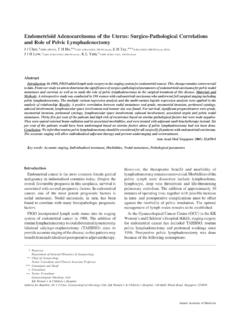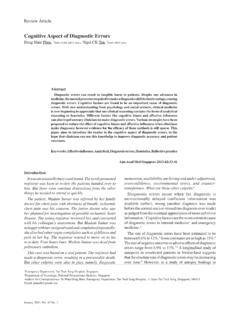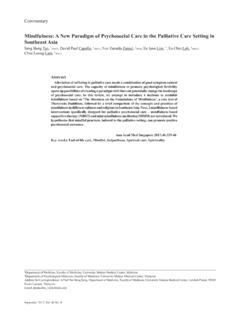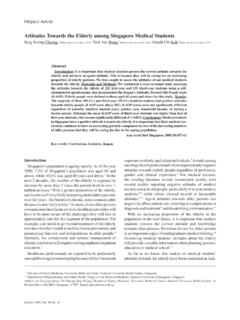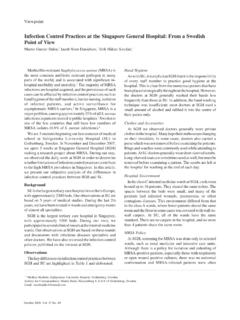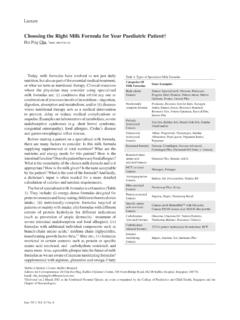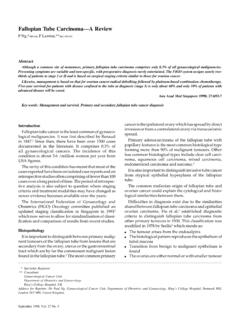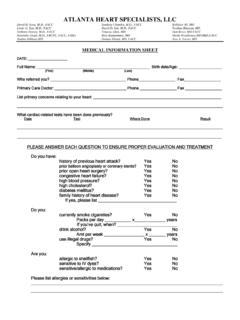Transcription of Right Atrial Mass: A Diagnostic Dilemma
1 100 Annals Academy of Medicine Right Atrial mass : A Diagnostic DilemmaDear Editor,The differential diagnoses of intracardiac masses include vegetation, thrombus or tumours. Size, shape, location, mobility and attachment of the mass combined with the clinical fi ndings help differentiate etiology. Echocardiography became the gold standard test for the diagnosis of intracardiac masses and later on transesophageal echocardiography (TEE) further improved the accuracy. Magnetic Resonance Imaging (MRI) can identify the amount of fat with a high degree of specifi city and can be used to diagnose cardiac is crucial to establish a correct diagnosis for proper management and discuss a patient diagnosed with renal cell carcinoma (RCC) who presented with a Right Atrial mass identifi ed as a thrombus by TEE and lipoma by MRI. Because of the strong clinical suspicion for thrombus, she was maintained on anticoagulation and repeated TEE after 6 months showed resolution of the mass , confi rming the initial diagnosis of ReportA 41-year-old woman was admitted for dyspnoea and leg edema.
2 She had a history of uterine fi broids and menometrorrhagia. Physical Examination showed BP of 120/80 mmHg, pulse 118 bpm, respirations 24/minute and temperature of 98 F. Haemoglobin was gm/dl. Electrocardiogram showed sinus tachycardia, 118 bpm; Atrial fi brillation was not documented. Transthoracic echocardiography (TTE) demonstrated a dilated left ventricle with global hypokinesia and reduced systolic ejection fraction (EF) of 35%. Later, she underwent cardiac catheterisation and coronary artery disease was ruled out. She received 3 units of blood and furosemide intravenously as well as enalapril, carvedilol and digoxin. After blood transfusion, her haemoglobin increased to gm/dl. Computed Tomography (CT) scan of the abdomen and pelvis reported a heterogeneous fi broid uterus and a Right renal tumour. There was also a hypodense lesion within the Right atrium. Invasion from a possible renal cell carcinoma was suspected.
3 TEE confi rmed a mobile mass , measuring cm localised in the Right Atrial appendage, suggestive of thrombus (Fig. 1A). Anticoagulation was started with of the heart with gadolinium showed a cm mass in the Right atrium, which became imperceptible or dropped in signal with fat suppression sequences compatible with lipoma. Neither TEE nor MRI showed tumour invasion via the inferior vena of the abdomen with gadolinium showed a cm complex mass arising from the anterior aspect of the interpolar region of the Right kidney, which enhanced with contrast and was suspicious for renal cell carcinoma. The Right renal vein and inferior vena cava were patent without thrombus or tumour. Nephrectomy and hysterectomy were performed. Pathology confi rmed renal cell carcinoma without lymphovascular involvement. The uterus showed multiple leiomyomas. The most likely cause of impaired left ventricular (LV) dysfunction is cardiomyopathy of unknown was discharged home with oral anticoagulation.
4 After 6 months, a repeated TEE showed resolution of the mass , confi rming the initial diagnosis of thrombus (Fig. 1B), LV function normalised: EF 55%.DiscussionOnce malignant infi ltration of the Right atrium was ruled out, the patient represented a diffi cult Diagnostic Dilemma Fig. 1A. Atrial mass Abdur Baig et alLetter to the Editor February 2011, Vol. 40 No. 2101due to discrepancy between 2 imaging modalities. Right -sided cardiac thrombus has long been recognised but few have been reported. Earliest cases were based on post mortem Echocardiography including TEE is the most common modality utilised to establish the diagnosis. Size, shape, location, mobility and attachment of the mass help differentiate etiology. Atrial enlargement, low cardiac output state and Atrial fi brillation favour the diagnosis of Thrombus may be a complication of malignancy and a frequent cause of death in cancer The European Cooperative Study on the clinical signifi cance of Right heart thrombi identifi ed 2 different types: Type A is long and thin and extremely mobile resembling a worm, usually originating in peripheral veins and placing patients at risk of pulmonary embolism.
5 Type B is less mobile, developing within the chamber when there are thrombogenic cardiac abnormalities . They are more benign and pulmonary embolism although not uncommon (40%) is not frequently Our patient had a Type B thrombus with mobile modalities to differentiate cardiac masses are cardiac CT, contrast echocardiographic perfusion imaging and MRI. MRI has the ability to characterise tissue composition because of its spatial resolution with superior soft tissue contrast. It also assesses the precise cardiac and extracardiac anatomy and the effects of the These unique properties make MRI an ideal second line noninvasive modality in the evaluation of a cardiac mass . Primary tumours of the heart are rare, occurring at a frequency of in pooled autopsy Myxomas are the most common benign tumours followed by lipomas. Sarcomas are the most common primary malignant involvement of the heart is relatively common and may be observed with melanoma, lung cancer, breast cancer and renal cell carcinoma.
6 Malignant tumours are highly vascularised and enhance with contrast. Our patient s cardiac mass did not enhance with gadolinium and did not extend into the inferior vena thrombus, on the other hand, usually show delayed enhancement on MRI, a feature that was not observed in our are benign cardiac neoplasms that appear as hyperechoic, homogeneous mass in In MRI, lipoma appearing as homogeneous increased signal intensity on T1-weighted images that decreased with fat-saturated sequences,1 featured that were observed in our case. They do not enhance with gadolinium due to the lack of vascularity. As there was strong clinical suspicion for thrombus, it was decided to continue anticoagulation. The regression of the mass after 6 months as shown by TEE confi rmed the initial echocardiographic impression of thrombus since spontaneous regression of lipoma is highly 1B. Post-treatment. REFERENCES 1.
7 Araoz PA, Mulvagh SL, Tazelaar HD, Julsrud PR, Breen JF. CT and MR imaging of benign primary cardiac neoplasms with echocardiographic correlation. Radiographics 2000;20 Radding RS. Ball thrombus of the Right auricle. Am J Med 1951;11 Alam M. Pitfalls in the echocardiographic diagnosis of intracardiac and extracardiac masses. Echocardiography 1993;10:181 91. 4. Donati MB. Cancer and thrombosis: from Phlegmasia alba dolens to transgenic mice. Thromb Haemost 1995;74 European Working Group on Echocardiography. The European Cooperative Study on the clinical signifi cance of Right heart thrombi. Eur Heart J 1989;10:1046 Sparrow PJ, Kurian JB, Jones TR, Sivananthan MU. MR imaging of cardiac tumors. Radiographics 2005;25:1255-76. 7. Reynen K. Frequency of primary tumors of the heart. Am J Cardiol 1996;77 Mousseaux E, Idy-Peretti I, Bittoun J, Diebold B, Paulylaubry C, Carpentier A, et al.
8 MR tissue characterization of a Right Atrial mass : diagnosis of a lipoma. J Comput Assist Tomogr 1992;16 Baig,1MD, Sonia Borra,1MD, FACP, Norbert Moskovits,2 MD, FACC, Adnan Sadiq,2 MD, FACC, Manfred Moskovits,1,2 MD, FACC1 Department of Medicine, Kingsbrook Jewish Medical Center, Brooklyn, NY 11203 2 Division of Cardiology, Maimonides Medical Center, Brooklyn, NY 11219 Address for Correspondence: Dr Manfred Moskovits, Cardiology Suite Kings-brook Jewish Medical Center, 585 Schenectady Avenue, Brooklyn, NY : Right Atrial mass Abdur Baig et al

